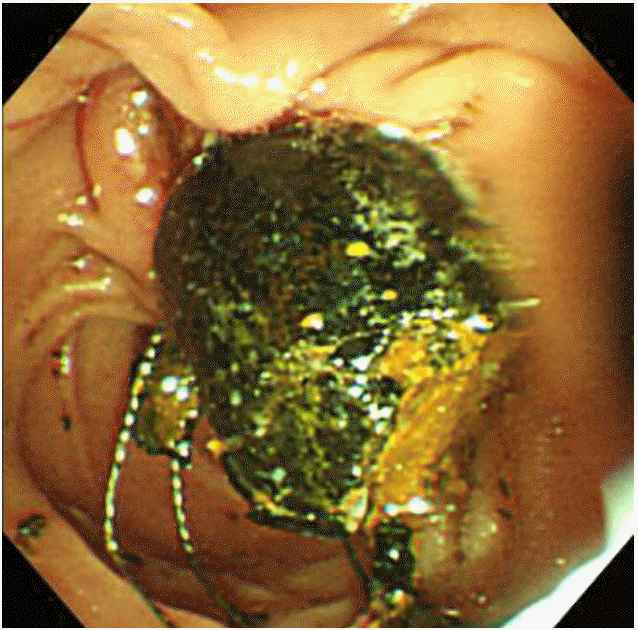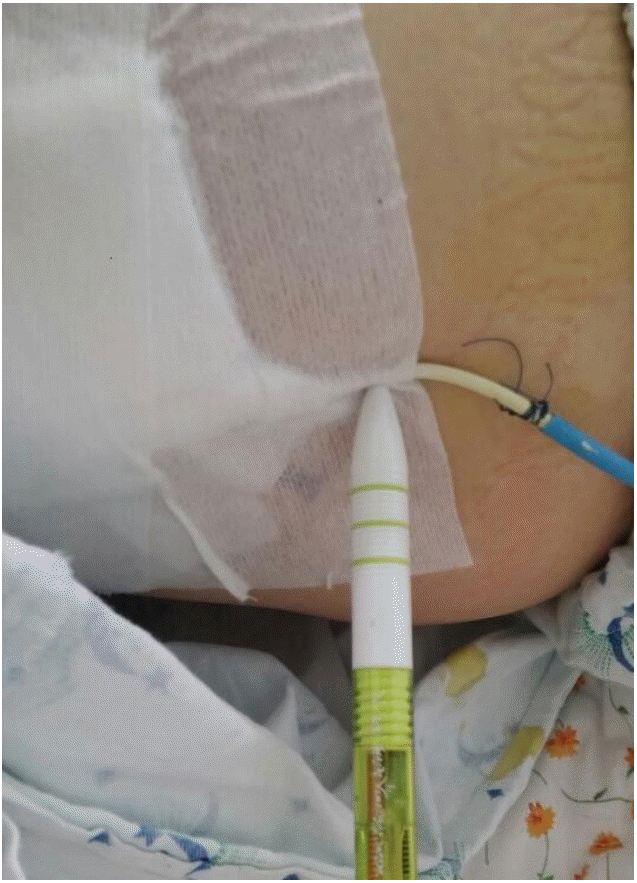INTRODUCTION
Percutaneous transhepatic biliary drainage (PTBD) is a modality that is used to decompress obstructive jaundice due to impacted stones, benign stricture or cancer [1-5]. It has been reported to produce intra- and post-procedural complications such as sepsis, cholangitis, bile leak, hemorrhage, pneumothorax and dislodgement of the catheter [6-8]. Although rare, the PTBD catheter may migrate into the peritoneal cavity during the removal of it.
We experienced a case of a 62-year-old man with peritonitis due to the migration of the PTBD catheter into the peritoneal cavity during the removal of it. Here, we report our case with a review of literatures.
CASE
A 62-year-old man visited us with chief complaints of right upper-quadrant (RUQ) pain and febrile sense. On physical examination, the patient showed blood pressure 90/60 mmHg, pulse rate 120/min, respiratory rate 22 breaths/min, and body temperature 39.1°C. Moreover, the patient also had severe tenderness on the RUQ. On clinical laboratory tests, the patient had a white blood cell count of 4,900/mm3, hemoglobin 10.9 g/dL, platelet counts of 182,000/mm3, total bilirubin 9.96 mg/dL, AST 144 IU/L, ALT 184 IU/L, alkaline phosphatase 671 IU/L, amylase 797 IU/L, lipase 2,497 IU/L, Erythrocyte sedimentation rate 45 mm/hr, and C-Reactive protein 17 mg/dL. In addition, on blood coagulation test, the patient showed Prothrombin tme/activated partial thromboplastin time 11/31 seconds. On abdominal computed tomography (CT) scan, the patient had biliary tree dilatation and gallbladder distension due to two common bile duct (CBD) stones (Fig. 1).
On day 1, the patient had a decrease in blood pressure to 75/40 mmHg. The patient therefore, underwent emergency percutaneous transhepatic gallbladder drainage and PTBD rather than endoscopic retrograde cholangiopancreatography (ERCP) (Fig. 2). On day 9, CBD stones were removed by basket after ERCP (Fig. 3). On day 16, the patient underwent laparoscopic cholecystectomy. On day 19, the patient had migration of the PTBD catheter into the peritoneal cavity during the percutaneous removal of it at the bedside (Fig. 4). Then, the patient complained of abdominal pain. On abdominal CT scan, the patient had the tip of the PTBD catheter located in the abdominal cavity, which was accompanied by the detection of pneumoperitoneum (Fig. 5). The patient underwent emergent ERCP. After sweeping of the CBD by an extraction balloon, the PTBD pigtail catheter tip was pulled out into the duodenum through the ampulla. The catheter tip was held by grasping forceps and retrieved with an endoscope (Fig. 6). On day 30, the patient was discharged without complications.
Discussion
Approximately 10-15% of large stones are impacted in the bile duct and cannot be retrieved using conventional ERCP methods such as a balloon, basket, or mechanical basket lithotripsy [9]. These cases pose challenging problems for clinicians; endoscopic managements, such as endoscopic papillary large balloon [10], direct cholangioscopy using an ultraslim [11-13] and stenting with oral dissolution therapy in geriatric patients [14,15], have been attempted for the treatment of large CBD stones. ERCP has been recognized as the mainstay of therapy for the cholangitis secondary to biliary obstructions, such as CBD stones. However, the ERCP may be difficult or impossible in some clinical situations, including previous operation of the upper gastrointestinal (GI) tract, cardiopulmonary instability, patients’ intolerance or phobia for endoscopy, and anomalies of the GI tract, which require alternative therapeutic modalities such as PTBD [3]. The PTBD catheter has been reported to produce intra- or post-procedural complications [6-8]. Of these, the most common intra-procedural complication is the infection, such as an abscess, cholangitis, peritonitis, cholecystitis, pancreatitis or sepsis. Moreover, it may also cause hemobilia such as hepatic venous bleeding, portal venous bleeding, hepatic arterial bleeding and tumor bleeding. Furthermore, it may also produce pleural complications such as pleural effusion, empyema, pneumothorax, hemothorax, and biliopleural fistula. On the other hand, post-procedural complications, such as bile leak, anastomotic strictures, and PTBD tube dislodgement of PTBD tube [9]. One may assume that internal migration of the PTBD catheter is one of the procedural complications. To our knowledge, however, this has not been described in the literature. The PTBD catheter is removed percutaneously after the restoration of internal biliary drainage.
In the current case, the patient underwent ERCP for the removal of CBD stones, followed by a laparoscopic cholecystectomy. During the removal of the PTBD catheter, the cutting tube moves depending on the respiration. With the migration of the PTBD catheter into the peritoneal cavity, the patient had peritonitis. The PTBD tube could not be removed percutaneously because its outer tip was completely invisible. It was unavoidable, however, to remove the migrated PTBD catheter causing peritonitis. Therefore, we first considered the ERCP as a modality to remove it. Otherwise, we planned to perform surgical operations. After sweeping of the CBD by an extraction balloon, the PTBD pigtail catheter tip was pulled out into the duodenum through the ampulla. The catheter tip was held by grasping forceps and retrieved with an endoscope.
Although rare, the PTBD catheter may migrate into the peritoneal cavity during the removal of it. In these cases, clinicians should consider the peroral endoscopic removal of the PTBD catheter. Its migration into the peritoneal cavity should be prevented during the removal of it. Therefore, the PTBD tube should be seized by grasping forceps and the length of the remaining part should be relatively greater in cutting the PTBD tube.


















